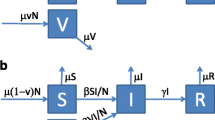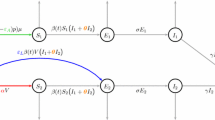Abstract
Along with the constant improvement in hygiene in the last few decades there has been a continuous increase in the incidence of particular diseases, mainly of autoimmune or allergic etiology, but also of diseases caused by infectious agents, such as listeriosis. We here present a model for the effect of exposure to agents causing or inducing the disease on the incidence of morbidity. The proposed model is an expansion of the SIR model to non-contagious diseases and aims to estimate the balance between immunization and disease probability. The model results indicate that, paradoxically in a wide range of parameters, a decrease in exposure to the disease inducing agent results in an increase in disease incidence. This can occur if: (a) the probability of developing disease, given an exposure to the agent increases with age, (b) immunity to the agent is long. The inverse relation between exposure and disease incidence results from a decrease in the adult immunized population following a previous decrease in the exposure rate. Therefore, a lower exposure can lead to lower incidence in the short term but to higher incidence in the long term.
Similar content being viewed by others
References
Anderson, R. M., & May, R. M. (1983). Vaccination against rubella and measles: quantitative investigations of different policies. J. Hyg. (Lond.), 90(2), 259–325.
Antal, E. A., Hogasen, H. R., Sandvik, L., & Maehlen, J. (2007). Listeriosis in Norway 1977–2003. Scand. J. Infect. Dis., 39(5), 398–404.
Coleman, P. G., Perry, B. D., & Woolhouse, M. E. (2001). Endemic stability—a veterinary idea applied to human public health. Lancet, 357(9264), 1284–1286.
Cooke, A. (2009). Infection and autoimmunity. Blood Cells Mol. Dis., 42(2), 105–107.
Darji, A., Mohamed, W., Domann, E., & Chakraborty, T. (2003). Induction of immune responses by attenuated isogenic mutant strains of Listeria monocytogenes. Vaccine, 21(Suppl 2), S102–109.
Gillespie, I. A., McLauchlin, J., Grant, K. A., Little, C. L., Mithani, V. et al. (2006). Changing pattern of human listeriosis, England and Wales, 2001–2004. Emerg. Infect. Dis., 12(9), 1361–1366.
Goossens, P. L., & Milon, G. (1992). Induction of protective CD8+ T lymphocytes by an attenuated Listeria monocytogenes actA mutant. Int. Immunol., 4(12), 1413–1418.
Goulet, V., Hedberg, C., Le Monnier, A., & de Valk, H. (2008). Increasing incidence of listeriosis in France and other European countries. Emerg. Infect. Dis., 14(5), 734–740.
Koch, J., & Stark, K. (2006). Significant increase of listeriosis in Germany—epidemiological patterns 2001–2005. Euro Surveill., 11(6), 85–88.
Lack, G. (2008). Epidemiologic risks for food allergy. J. Allergy Clin. Immunol., 121(6), 1331–1336.
Lara-Tejero, M., & Pamer, E. G. (2004). T cell responses to Listeria monocytogenes. Curr. Opin. Microbiol., 7(1), 45–50.
Lavi, O., Louzoun, Y., & Klement, E. (2008). Listeriosis: a model for the fine balance between immunity and morbidity. Epidemiology, 19(4), 581–587.
McBride, G. B., & French, N. P. (2006). Accounting for age-dependent susceptibility and occupation-dependent immune status: a new linear analytical SIR model. WSEAS Trans. Math. Conf., 5(11), 1109–2769.
Munk, M. E., & Kaufmann, S. H. (1988). Listeria monocytogenes reactive T lymphocytes in healthy individuals. Microb. Pathog., 5(1), 49–54.
Pamer, E. G. (2004). Immune responses to Listeria monocytogenes. Nat. Rev. Immunol., 4(10), 812–823.
Sauders, B. D., Pettit, D., Currie, B., Suits, P., Evans, A. et al. (2005). Low prevalence of Listeria monocytogenes in human stool. J. Food Prot., 68(1), 178–181.
Sun, J. C., & Bevan, M. J. (2003). Defective CD8 T cell memory following acute infection without CD4 T cell help. Science, 300(5617), 339–342.
Vazquez-Boland, J. A., Kuhn, M., Berche, P., Chakraborty, T., Dominguez-Bernal, G. et al. (2001). Listeria pathogenesis and molecular virulence determinants. Clin. Microbiol. Rev., 14(3), 584–640.
Author information
Authors and Affiliations
Corresponding author
Rights and permissions
About this article
Cite this article
Lavi, O., Klement, E. & Louzoun, Y. Effect of Vaccination in Environmentally Induced Diseases. Bull Math Biol 73, 1101–1117 (2011). https://doi.org/10.1007/s11538-010-9554-z
Received:
Accepted:
Published:
Issue Date:
DOI: https://doi.org/10.1007/s11538-010-9554-z




